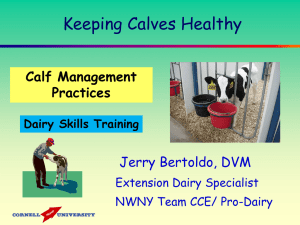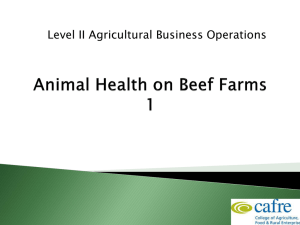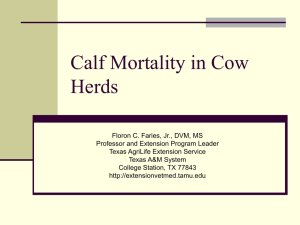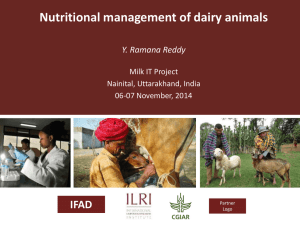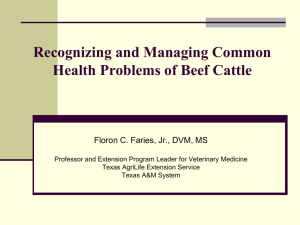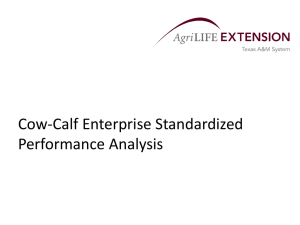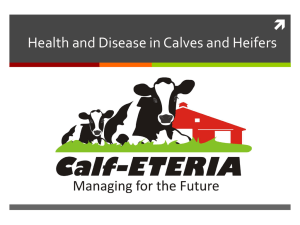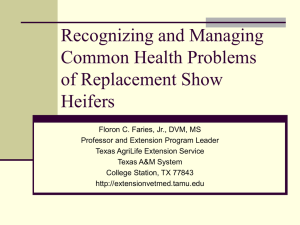Dairy calf respiratory disease
advertisement
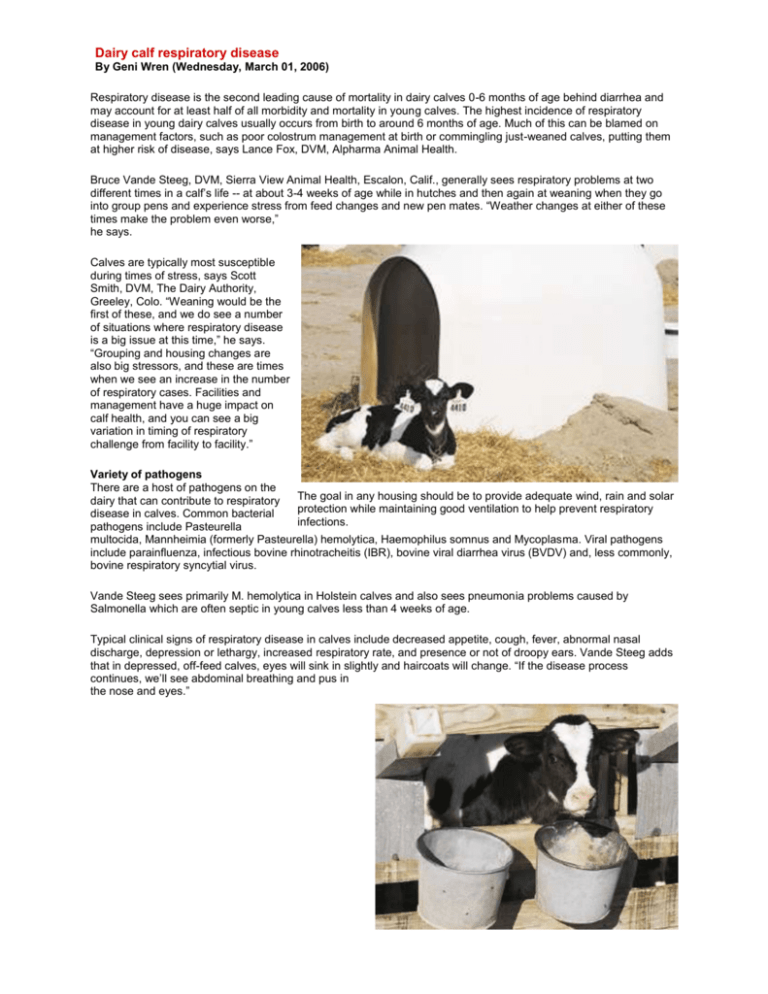
Dairy calf respiratory disease By Geni Wren (Wednesday, March 01, 2006) Respiratory disease is the second leading cause of mortality in dairy calves 0-6 months of age behind diarrhea and may account for at least half of all morbidity and mortality in young calves. The highest incidence of respiratory disease in young dairy calves usually occurs from birth to around 6 months of age. Much of this can be blamed on management factors, such as poor colostrum management at birth or commingling just-weaned calves, putting them at higher risk of disease, says Lance Fox, DVM, Alpharma Animal Health. Bruce Vande Steeg, DVM, Sierra View Animal Health, Escalon, Calif., generally sees respiratory problems at two different times in a calf’s life -- at about 3-4 weeks of age while in hutches and then again at weaning when they go into group pens and experience stress from feed changes and new pen mates. “Weather changes at either of these times make the problem even worse,” he says. Calves are typically most susceptible during times of stress, says Scott Smith, DVM, The Dairy Authority, Greeley, Colo. “Weaning would be the first of these, and we do see a number of situations where respiratory disease is a big issue at this time,” he says. “Grouping and housing changes are also big stressors, and these are times when we see an increase in the number of respiratory cases. Facilities and management have a huge impact on calf health, and you can see a big variation in timing of respiratory challenge from facility to facility.” Variety of pathogens There are a host of pathogens on the The goal in any housing should be to provide adequate wind, rain and solar dairy that can contribute to respiratory protection while maintaining good ventilation to help prevent respiratory disease in calves. Common bacterial infections. pathogens include Pasteurella multocida, Mannheimia (formerly Pasteurella) hemolytica, Haemophilus somnus and Mycoplasma. Viral pathogens include parainfluenza, infectious bovine rhinotracheitis (IBR), bovine viral diarrhea virus (BVDV) and, less commonly, bovine respiratory syncytial virus. Vande Steeg sees primarily M. hemolytica in Holstein calves and also sees pneumonia problems caused by Salmonella which are often septic in young calves less than 4 weeks of age. Typical clinical signs of respiratory disease in calves include decreased appetite, cough, fever, abnormal nasal discharge, depression or lethargy, increased respiratory rate, and presence or not of droopy ears. Vande Steeg adds that in depressed, off-feed calves, eyes will sink in slightly and haircoats will change. “If the disease process continues, we’ll see abdominal breathing and pus in the nose and eyes.” Therapy Shorting the calf on protein will have a negative effect on the Successfully treating respiratory disease in young development of the immune system. calves depends on what primarily is causing the pneumonia. Most cases eventually have some bacterial involvement and antibiotics can be of some value. “Early identification is essential if we are to be successful with any therapy,” says Smith. Antibiotic sensitivities and MICs can be of some value in making antibiotic treatment choices, but antibiotics are often of little value if Mycoplasma is involved as a pathogen. As far as supportive care, Smith recommends NSAID therapy and vitamins E and Bcomplex. “I also like to use temperature-sensitive IBR intranasal vaccine as a non-specific immune stimulant.” Prevention is certainly better than treatment, and the latter can be greatly influenced by how quickly a calf is pulled for treatment. “The degree of lung damage at the time treatment is instituted can dictate how well an antibiotic works,” says Fox. Vande Steeg says treatment must be done early and aggressively. “We use antibiotics and NSAIDs if needed,” he says. If the calves are dehydrated, he uses oral electrolytes and if severe, subQ or IV fluids. “We set up our protocols to have first-line and second-line antibiotics and instructions on when to change course of therapy.” Start at birth Failure of passive transfer leaves the calf vulnerable to many diseases, including respiratory disease. “If the calf’s immune system is not adequately ‘primed’ by the administration of enough good-quality colostrum in a timely matter, its immune system may not be able to recognize and therefore mount an adequate immune response in the face of a pathogenic challenge,” says Fox. Lack of colostrum raises the risk the calf will be treated for pneumonia at an early age, such as 5-10 days because it is breathing hard and is acidotic from severe diarrhea and sepsis. “If a calf gets an appropriate amount of colostrum and a healthy environment to live in, it will have very slim odds of getting pneumonia,” notes Vande Steeg. “We don’t even vaccinate dairy heifers with a respiratory vaccine until 4-5 months on our dairies that have good colostrum programs because the calves don’t need the extra immune boost from the vaccine -- they have immunity already.” Nutrition The immune system requires a suitable plane of nutrition in order to operate effectively. “It has been estimated that close to 25% of the daily energy fed to a calf is used by the immune system alone,” explains Fox. Proper dry matter and energy intake is critical in providing resistance to disease in young calves. “If we are shorting the calf on protein, this will have a negative effect on the development of the immune system,” notes Smith. If levels of dissolved solids are checked, especially in calves being fed unfortified waste milk, those calves are often deficient by up to 15-20% of their required dry matter intake on a daily basis. “This is a critical shortage, especially in those really young calves that are not yet consuming much dry feed.” Vande Steeg agrees that proper nutrition is critical. “Nutrition plays a huge role in keeping calves healthy. I tell clients, ‘What do you think antibodies are made of? Protein. So if you don’t feed protein to calves, they can’t make antibodies.’ A healthy calf doesn’t have much reason to get sick. We just think all calves should get sick because we have let the abnormal become normal.” Housing Calves can be raised successfully in a variety of housing styles, which, of course, will vary depending on geography. How the housing is managed may be more of an influence than type of housing. The calf hutch, for example, is an ideal all-in-all-out system. “When the calf exits, so should everything else including manure, bedding, feed, etc.,” says Fox. Smith likes to see single-calf hutches that do not allow nose-to-nose contact for the preweaned calf, followed by open-air pens with shelter for older calves. Vande Steeg also likes individual hutches either in the open or in a calf-barn if designed with good ventilation and wind protection. For weaned calves, he likes to start off with small pens of eight to 12. “Let them acclimate to pen mates and new food, then start to group them into larger groups of 2030 and then to large group pens.” Ventilation plays a critical role in disease. Fox notes that a calf up to 2 months of age requires a 50 cfm (cubic feet per minute) ventilation rate (air exchange) in mild weather. This is in contrast to that same calf requiring 100 cfm during hot weather and only 15 cfm in cold. “The goal in any housing should be to provide adequate wind, rain and solar protection while maintaining good ventilation,” he adds. The worst types of calf housing are closed-in, poorly ventilated barns. Grouping of calves together from a young age and overcrowding, regardless of age, often leads to increased respiratory disease. “Low-roofed barns with a lot of moisture are the worst,” says Vande Steeg. “Mixing calves of different ages and large groups of just-weaned calves are bad.” Abrupt changes in temperature, such as those that occur during the fall and spring (i.e. nighttime versus daytime temperature variability) seasons tend to increase the incidence of respiratory disease. Vande Steeg adds that when the weather swings about 40 degrees in any season of the year, he sees more pneumonia, as well as when the seasons change. Other management factors As discussed previously, poor colostrum management, inadequate housing (i.e. not only the housing itself but overcrowding, as an example), stress and poor nutrition are management factors that can contribute to respiratory disease. Fox cites the “five C’s” of calf raising originated by Sheila McGuirk, DVM: colostrum, calories, comfort, cleanliness and consistency. “Good management is best,” says Vande Steeg. “Solving the problem is next best. Fixing facilities or people problems is always the most rewarding and economical. Vaccines are almost always a bandaid. There are situations where they are the most appropriate, and a good diagnostician can determine this.” Vaccines for respiratory disease prevention in calves are available, and Fox notes that no one set protocol works for every operation. “Challenges on one operation will differ from those on a farm ‘just down the road,’” he says. “Keep in mind that a good vaccination program for calves really starts in the dry cow while that calf is still a developing fetus.” Smith believes aggressive vaccination of calves prior to expected periods of risk can be very useful in certain instances where respiratory disease is a problem. Also, changing grouping patterns in commingling situations can be of some use in certain management systems. Lance Fox, DVM, says the highest incidence of respiratory disease in young dairy calves usually occurs from Smith sees fewer problems with respiratory disease in calf groups birth to 6 months of that are doing persistent infection (PI) BVDV screening and removing age. PI calves at an early age. Monitor disease incidence Calves are typically Whether you are working with dairies that raise their own calves or larger calf/heifer most susceptible operations, monitoring the disease incidence and factors associated with disease is during times of stress, important. Smith likes to do a quick visual inspection of the youngstock at least twice a month says Scott Smith, DVM. on the facilities he works with, and many of them get looked at even more frequently. “I also visit with the calf-area manager on a regular basis to keep up with challenges the calves may be facing,” Smith adds. “Routine postmortem exams are important to keep track of what is causing mortality and to catch ‘new’ problems early. I would encourage others to have a routine that they go through with their calf raisers.” Vande Steeg believes calf respiratory disease is an area many veterinarians have little time for because they are busy checking cows. “But, if you show an interest to the calf person, he/she will respond and start to show you cases, and you can get involved and help train them. It really makes an impact.” Bruce Vande Steeg, DVM, says good management is the key to preventing calf Depending on the situation, you can see mortality rates from pneumonia in preweaned calves respiratory disease. as high as 10-15%, says Scott Smith, DVM. “Most well-managed facilities will run less than 2% mortality throughout the entire calf rearing period. I don’t have any hard numbers about growth rates, but some Mortality and performance calves will develop chronic respiratory lesions and get stunted in their growth.” Smith says most of these calves will lag one to two months behind their original pen mates. He estimates that about 1-2% of calves in well-managed herds will be stunted, and the number goes up as challenge and disease levels increase. Many of these calves will end up being culled out during the growing/breeding period and will not return to the milking herd. Lance Fox, DVM, agrees and says studies documenting performance loss due to respiratory disease are a little more vague versus enteric diseases, yet accepted negative aspects include reduced growth rate, delayed calving age and an increased risk of being culled during the first lactation. “For example, often you’ll see literature cite that 50% of heifer deaths are due to pneumonia from birth through calving, whereas in just the first three weeks of life, scours causes around 62% of mortality.” “The calves definitely stop growing,” adds Bruce Vande Steeg, DVM. “So, if they were gaining 1.8 lbs./day, they are now either losing or just maintaining bodyweight. When they get better, they have to put that weight back on, and that takes time. So, the calf enters the milking string later and older, and/or smaller. Both cost money, but it is hidden money because it doesn’t come out of the checkbook directly. But, it does affect the profitability of the dairy.” Calf health scoring chart This Calf Health Scoring Chart created by Sheila McGuirk, DVM, PhD, University of Wisconsin, can help you better assess your clients’ calves and make decisions on when to treat.

